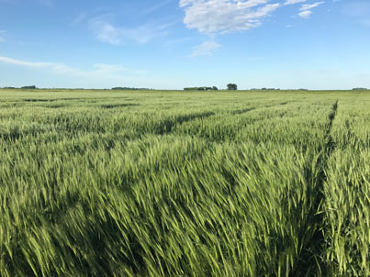By Jared Goplen

Spring wheat yields in Minnesota reached an all-time high in 2017, with an average of 67 bushels per acre, according to the USDA National Agricultural Statistics Service. University of Minnesota-developed varieties constituted over half of the spring wheat varieties grown in Minnesota in 2017, with varieties Linkert and Bolles leading the way. Along with improved genetics, the record-breaking yields are largely attributable to the cool summer weather during the grain filling period.
Small grains have the attention of many Minnesota farmers going into the 2018 growing season as corn and soybean prices have been poor, and herbicide resistant weeds, soybean cyst nematode, soybean aphid, corn rootworm, and other diseases have become increasingly problematic. Since small grains can help alleviate those issues, they often lead to improved crop yields and profitability in rotational crops.
Incorporating small grains into the rotation isn’t for the faint of heart, as intensive management is often needed in southern Minnesota to maximize yields and profitability. Heat, humidity, and disease oftentimes wreak havoc on small grains in southern Minnesota. To avoid heat stress and disease issues, it is important to get small grains seeded early. Farmers should have the drill ready so they’re prepared to seed small grains the end of March, as long as field conditions are favorable. Once the crop is in the ground there are numerous management decisions that need to be made. Fields need to be scouted regularly, as plant diseases or insects can show up any time and cause yield loss. In order to protect high-end yield potential, it is important to have control options on stand-by ready to go.
Another benefit of incorporating small grains into the rotation is that they are harvested in late-summer, which provides ample time for the establishment of a cover crop to either be grazed or used as a green manure crop. For livestock producers, adding a forage cover crop following small grain harvest can add significant value to the rotation, as 1-4 tons of dry matter can accumulate before fall which can be grazed or baled for hay. Research found a cost savings of $25 - $55 per beef cow per month over traditional rations being fed during the overwintering months, which further adds to small grain profitability.
Although it can be difficult to determine the value of adding a small grain into the crop rotation, there are numerous agronomic and economic benefits to doing so, along with the ability to improve soil health characteristics along the way. By reducing insect and disease pressure and providing a “rotational-effect” yield boost for rotational crops, small grains in the rotation can increase overall farm profitability. For livestock producers, there can be value in the production of straw from the small grain, as well as the opportunity to seed a forage cover crop following harvest.
Source: umn.edu